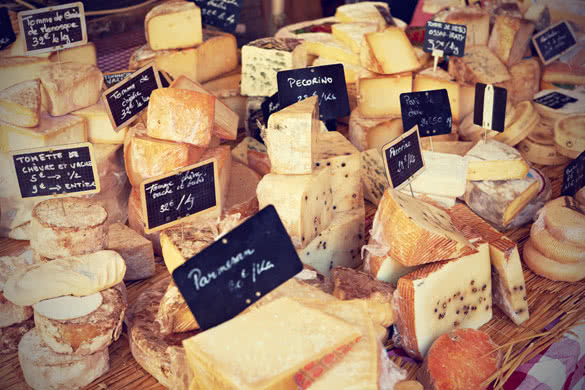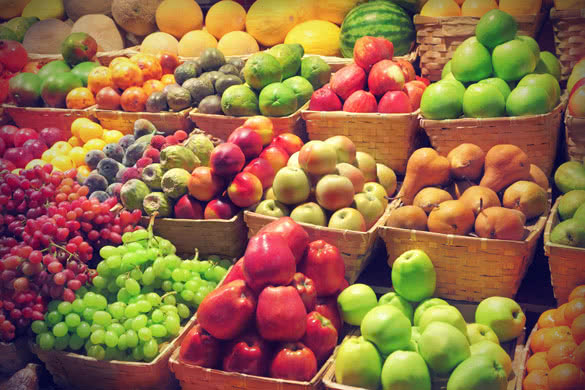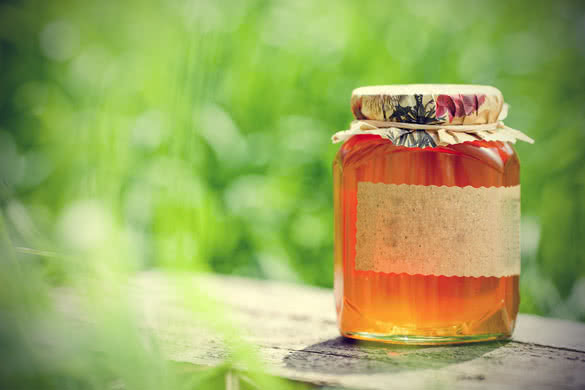Cooking with fresh ingredients is the best (and in my opinion, only) way to get maximum flavor. However, at the end of the week, we often find ourselves throwing out all that beautiful food that has surpassed its peak. Instead of letting this food spoil, and avoiding multiple trips to the grocery store, it’s time to implement some techniques on how to keep food fresh for days.
Storage is one of the easiest ways to maintain food freshness. Surprisingly, this is also one of the areas where most people go wrong. When it comes to produce, keep the items separate. Certain items have a shorter shelf life than others, and when one thing starts going rotten, these germs spread easily and act as a catalyst for the spoiling of surrounding items.
There are also plenty of ways to revive those items which haven’t completely spoiled, causing you to feel guilty about tossing it.
Cheese
When purchasing cheese, first look at the expiration dates. Grocery stores place items with an earlier expiration date at the front.
Don’t be afraid to dig in the back for products that will undoubtedly last longer. When storing them at home, take the cheese out of the original packaging. Wrap it in plastic wrap or wax paper, and place it in a plastic sealed bag.
For harder cheeses, a great way to keep it fresh is by spreading a thin bit of butter on the cut edges. This prevents the drying out of the cheese and maintains freshness for longer.
Also, cottage cheese (and sour cream) should be stored upside down. The vacuum sealing effect helps to prevent the growth of bacteria. Cheese also freezes well, due to its high fat content, especially softer cheeses. Feel free to freeze the cheese and defrost it in the fridge for one day before the next use.
Herbs
It always seems like the bunches of herbs at the grocery store are far too large for me to use within one week. There are multiple ways to keep herbs fresher longer.
What I like to do is store the herbs in the fridge in a cup or glass filled with water. I cut the ends on an angle and place them in the water. Then, I cover them loosely with a plastic bag. Changing the water and trimming the stems should be done every few days. The same can be done for kale, Swiss chard and collards.
One problem is that this can take up a lot of space in the fridge depending on how many herbs you have. Alternatives are wrapping the stems with a damp paper towel or placing in a plastic sealed bag in the freezer.
Vegetables
One of the most common mistakes people make is refrigerating vegetables that do not need to be refrigerated. Potatoes, garlic, cucumbers, onions, eggplant, ginger, jicama, peppers, tomatoes, squash, pumpkin, and sweet potatoes should not be kept out of direct sunlight in a cool area, not in the fridge.
That frees up a lot refrigerator space for the other vegetables which do require refrigeration. Proper storage for vegetables in the fridge does not include sealed plastic bags! This speeds up the spoiling process, as vegetables need to be able to breathe to stay fresher longer. Poke holes in the plastic bags.
Lettuce should be wrapped in paper towel instead of placed in a plastic bag. Line the refrigerator drawers with paper towels to absorb excess moisture, another component that speeds up the spoiling process.
Mushrooms should be taken out of the original packaging and stored in brown paper bags on a shelf in the fridge. Celeries, carrots and radishes stay fresh and crisp for longer when stored in the fridge in a container of cold water.
Fruits
First thing’s first, under NO circumstances should fruit be stored amongst vegetables. As is the case with vegetables, there are certain fruits that should not be refrigerated. These include apples, grapefruit, limes, mangoes, papayas, plantains, watermelons, bananas, lemons, mandarins, oranges, pineapples, and pomegranates.
Some fruits should be ripened at room temperature and then stored in the fridge: avocados, nectarines, pears, peaches, plums, and kiwi.
Once again, it is advantageous to line the drawer with paper towels to absorb excess moisture and to poke holes in the plastic sealed bags used for storage. To extend the life of berries, wash them with a bit of vinegar.
Meat, Poultry, Fish
Meat, poultry and fish do well in cold temperatures. All of these can be frozen for an average of up to three months. However, if you are keeping them in the fridge, be sure to place them at the bottom. This is where the fridge is coldest and the meats will be preserved the best.
When it comes to freezing, a little trick that I like to do is to open the original package and individually wrap each piece of meat in plastic wrap. I then place all of the pieces in a large plastic sealed bag. This makes it easy to take out only the meat that I need as opposed to having to defrost the whole thing.
The best method for defrosting meat, poultry or fish is overnight in the fridge. Eggs should be kept in the refrigerator in their original carton as opposed to on the door in the plastic egg holder, as they remain fresher at cooler temperatures that the door does not provide.
Bread
Bread is a freezable food. When purchasing bread in bulk, it is ok to place a few loaves in the freezer.
Bread can also be kept in the refrigerator.However, its softness is sometimes compromised by doing so. Keeping bread on the counter or in the breadbox is perfectly acceptable.
For bread (and other bread products such as muffins) which has become slightly stale, simply sprinkle with a bit of water and place in a paper bag. Put the bread and bag in a preheated oven for approximately ten minutes.
Baking Products
Brown sugar is one of the most problematic baking ingredients. It always seems to go hard within two days, making it virtually impossible to use.
When brown sugar has hardened, simply place a slice of apple or bread in the storage container. To avoid soft brown sugar going hard, store it in the freezer. Always store baking ingredients in cool, dark places.
The same slice of bread trick can be used for stale marshmallows. Items such as flour, oatmeal, cornmeal, rice, pasta, and barley often become homes to insects. To keep these bugs away from your food, simply place a single bay leaf in the package. This will repel all unwanted guests.
Beverages
Milk should not be kept on the door. It is cooler in the actual refrigerator, and thus it will last longer. Skim milk also lasts longer than whole milk, and it often is good even after the expiration date.
A simple sniff test should tell you if the milk is still safe for consumption. To revive fizzy drinks that have lost their fizz, place a single raisin in the bottle. The bubbles should return and the fizziness revived!
Store tea in dry, cool places out of direct sunlight. Tea bags should be placed in airtight containers to maintain optimum freshness. Coffee should be stored the same way. It is not advised to store it in the refrigerator or freezer, as it may come into contact with moisture which is not conducive to ideal storage practices for coffee.
Honey
Honey is the only food that will never spoil. However, this does not translate to mean that it is always in a usable condition. I’m sure you have all experienced those dreaded crystallization effects that honey is so susceptible to.
When this reaction occurs, there is actually a way to restore honey to its original, sticky condition. Place the honey in a sauce pot of boiling water. After about ten minutes, it should be back to its liquid form.
The amount of time necessary may vary, depending upon the severity of the crystallization. As with most other items stored at room temperature, be sure to store your honey in cool, dry places and avoid direct sunlight.
Gadgets
There are many things that you can purchase to assist in your efforts of keeping food fresh for longer. Vacuum seal contraptions allow consumers to seal items such as meat, poultry and fish in airtight storage bags and containers.
There are also items to purchase to place in produce drawers. They absorb the harmful things in the air which speed up the spoiling process. For storage of vegetables and fruits, there are also containers available for purchase. These have certain settings for storing items with different storage needs, and they keep the produce separated from one another.
By following these simple tips, it is impossible not to see the effects on your kitchen and on your wallet. Do you have any additional suggestions or tips on how to keep food fresh for days? Or any tips on reviving foods that have surpassed its prime?
Cooking “Secrets” from Top Chefs
Now that you know how to keep food fresh for days, start cooking!
When it comes to cooking, there are so many tips and tricks that the top chefs know that aren’t exactly common knowledge for the rest of us. But, you can learn some of them, and you’ll be able to cook dishes that are worthy of 5-star ratings.
For example, if you’re cooking chicken in the oven, place it in a frying pan on top of thick, raw onion slices to enhance taste while still allowing the fat to drain, recommends Donald Link of Cochon in New Orleans, Louisiana. When it’s done, you can use the onion and leftover broth to make a very tasty gravy to complement your meal.
Find many more cooking tips from top chefs here.
















Add Comment